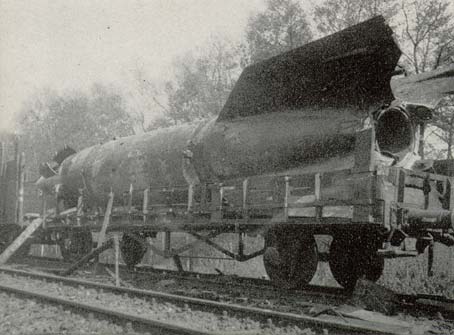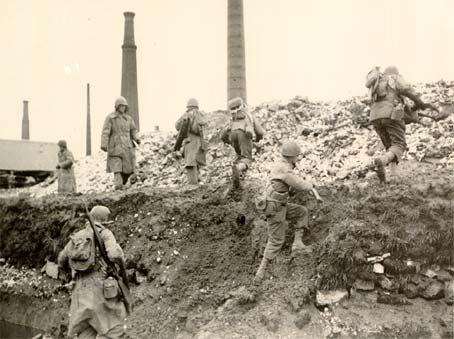| |
The Final Battle: April 12
- May 8, 1945
Gen. Eisenhower’s final offensive
for the conquest of Germany began on April 5, 1945. Objective:
the Elbe River, to be reached by April 12th. All the Allied
Armies launched blitz-like strikes eastward.
Gen. Simpson, commanding our Ninth U.S. Army, ordered the
83rd, 84th, and 30th Divisions with the 2nd Armored Division
to attack with speed in convoys along the Autobahn (a modern
concrete divided highway) which reached directly toward Berlin,
some 270 miles away. The route bypassed to the North the combat
divisions of the German Army encircled in the Ruhr. 320,000
German soldiers were surrounded and pounded by American Divisions
including the 35th Division in a steadily tightening noose.

A V-2-rocket bomb found near the
Elbe River.
On April 12th, Gen. Baade received orders for the 35th Division
to join the assault on the Elbe River, disengaging from the
fighting along the North edge of the Ruhr where it was then
assaulting along the Rhine-Herne Canal, and turning over its
sector to the 75th and 79th Divisions and pulling out units
as soon as they could be released. Gen. Baade ordered the
division to move by combat teams as soon as they were able
to do so, beginning with Combat Team 137 on April 12, followed
by Combat Team 320 on the 13th, Combat Team 134 on the 14th
of April, accompanied by attached tanks, tank destroyers,
engineers, and anti-aircraft units, the 35th G.I.’s
loaded into 2½ ton trucks, ½ ton trucks, and
jeeps and barreled along the Autobahn through fresh, beautiful
farmland and woods and some scattered towns along the way.
Admittedly, many apprehensive eyes were cast at the terrain
to right and left as we passed defensible hilltops and strategically
located possible roadblocks which could have concealed hidden
German guns and armor, just waiting to ambush speeding American
invaders. They weren’t there, but we did pass numerous
sites where only a few days before our spearheading American
divisions had decisive but brief encounters with disorganized
German defensive troops.
Near the City of Hamelen on the Weser River, we encountered
a bridge that had been destroyed, but Ninth Army Engineers
had lost no time in replacing it with a pontoon bridge. No
serious organized resistance faced the Combat Team 137 as
it closed into positions along the West bank of the Elbe River,
North of Magdeberg and in the vicinity of Stendall, reached
late on April 13.
The 320th Combat Team was not so fortunate. There was trouble
up ahead of which they were not aware as they road along enjoying
the freshness of the spring-like weather, crossing fields
and scattered woods. The 83rd Division had reached the Elbe
River, along with the 2nd Armored Division to its left, about
15 miles South of Magdeberg and had together forced a river
crossing and had troops and some tanks on the East side of
the Elbe River. That was the good news. Now for the bad news.
They didn’t have sufficient force to hold the bridgehead
against the developing counter attacks.
It seems that the 83rd Division, while passing the Harz Mountains
on its right about fifty miles before reaching the Elbe, a
rough mountain region of some 1500 square miles, had uncovered
the Germans in force, perhaps three divisions, ready to give
battle. The 83rd Division dropped off its 330th Infantry Regiment
to engage and contain this force while First Army Divisions
closed on the Harz Mountain retreat from the South. The Harz
Mountains contained deep underground factories which made
V-1 and V-2 rocket bombs for use against the British Isles,
and other factories making the new German jet fighters.

The 35th Division on the Saar River
at Sarreguemines.
So it was that our 320th Combat Team was intercepted on the
Autobahn and re-routed and attached to the 83rd Division to
replace its 330th Regiment now seriously occupied in the Harz
Mountains. The 320th Combat Team reached the Elbe River South
of Magdeburg and near Darby and joined the embattled 83rd
Division. On arrival on the 15th of April, our regiment was
ordered to attack immediately, across the Saale River where
it joined the Elbe River, and drive the German defenders from
the West bank of the Elbe. This action would help secure the
bridgehead and permit the engineers to put up a second pontoon
bridge across the Elbe without being under fire from the Germans
and supplementing the Harry Truman Bridge built in the initial
crossing. This became the last coordinated major attack for
a 35th Division unit and the last river crossing of the war
for us. Fortunately we accomplished our objective with light
casualties. We then crossed the Harry Truman Bridge and took
up positions to protect the bridgehead along its North side,
digging in, which wasn’t very reassuring as the ground
was level, with no cover, and we could look across the flat
Eastern fields and scattered woods which barely concealed
the German Panzer units and infantry which had been only recently
repulsed in their last counter attack of the 83rd’s
positions. At the moment the enemy did not seem particularly
aggressive, but there they were.
Captured German prisoners told us that the Germans would
rather surrender, if they had to, to the Americans rather
than to the Russian troops which were now fighting in East
Berlin, some 45 miles away from where we now were. We didn’t
know then that in January, 1945, at a conference in Moscow
of American and Allied and Russian leaders, it had been agreed
that the Elbe River would be the boundary line beyond which
the Americans were not to go. Gen. Eisenhower communicated
this on April 12th to his Army commanders. We now wonder how
generals like Patton and Simpson must have turned the air
blue around them when they got these orders!
At any rate, we were not to have the opportunity to find out
whether the Panzers would have let us through to Berlin. We
do know that the Germans attempted to attach a floating 500
pound bomb to the Truman Bridge by one of their underwater
swimming teams. The 60th Engineers and the 320th Riflemen
frustrated the attempt and captured two of the German swimmers
dressed in tight fitting black rubber suits. We assumed that
had the bridge been destroyed we likely would have had the
honor, if not the pleasure, of being the last 35th Division
unit to have faced a frontal counter attack by Panzers and
Infantry against an indefensible position. Fortunately it
didn’t happen. On April 22nd, Combat Team 320 was relieved
and released from the 83rd Division and moved westward across
the Truman Bridge to mount up on the trucks and resume the
trek to rejoin the 35th Division, going into reserve in the
rear of the 134th and 137th Regimental positions along the
West bank of the Elbe.
Resuming the story of the rest of the 35th Division, on April
15th came Combat Team 134, having been the last to leave the
Ruhr fighting, and closed along the Elbe River between the
137th Regiment, and spread very thin towards the 30th Division
which was in Magdeberg. The two regiments established several
isolated defensive positions which fought off several night
patrols from across the river. German prisoners were rounded
up in large numbers and over 1,500 Allied P.O.W.s were found
and released, fed, clothed, given medical care and sent home.
On April 16, the division was transferred from XIX Corps to
the XIII Corps, and on the same day sent patrols across the
Elbe to locate enemy positions and determine the best places
to cross the river if we were ordered to do so. Over 5,000
German prisoners were processed to P.O.W. camps including
top German officers like General Unrein and SS Gen. Heintz
Jost. Some scattered artillery dueling was conducted with
the enemy, more often at night.
We were aware that the 35th Division in the Stendel area
was the closest of any American division to Berlin when on
April 27th, the division was alerted to move again, this time
to the West. Relieved by the 102nd Division, we again mounted
our 2½ ton trucks and headed to the area around Hannover-Lehrte,
some 75 miles behind the front where the division entered
upon several weeks of military government duty in one of the
leading industrial and farming centers of Northern Germany,
an area that had a pre-war population of some 450,000 persons,
an area that had suffered heavily from Allied bombing and
destruction.
New duties were added to the old of rounding up P.O.W.s,
chasing down small bands of die-hard Nazis who still had weapons
and ammunition, rounding up, feeding and controlling displaced
persons by the thousands, freeing slave labor, restoring civil
government under Allied supervision, helping civilians resume
living and caring for themselves, like assisting farmers to
find seed potatoes for the Spring planting, restoring order
and helping shattered or isolated communities to function
again.
We followed the news carefully, radio reports, the stars and
stripes, and discussed and analyzed rumors which came from
every source. The link-up of the Russians and the Americans
in the 69th Division area, at Torgeau on the Elbe River about
50 miles South of where we had fought, focused attention on
the final collapse of Germany. We speculated on the where
abouts of Hitler, and didn’t know at the time that he
was in a bunker in Berlin, so close to where we were, or that
on April 30th he had shot himself. We knew that Mussolini
had been caught in Italy by partisans and executed. We learned
that the German Army in Italy had surrendered. All signs pointed
toward the imminent cessation of hostilities.
Of greater interest to some G.I.s was the prospect of furloughs
to the French Riviera, and other exotic places – Paris,
Brussels, London. And the prospects of just going home. It
is May 7, 1945 and tomorrow is just another day. Or is it?
 Continue
to Page 5 of 5 Continue
to Page 5 of 5
|